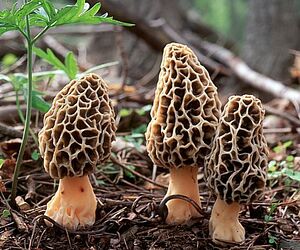
Hunting wild mushrooms can be dangerous - many edible mushrooms look very similar to poisonous ones. Even with a full-color field guide, it can be hard to tell the good ones from the bad ones.
- "There are old mushroom hunters, and there are bold mushroom hunters. There are no old, bold mushroom hunters."
Morels in the United States[edit | edit source]
An exception in the United States is the Morel mushroom (Morchella deliciosa[verification needed], esculenta and conica). There are only three varieties in the United States, easily distinguished from each other, all are edible, and there are no poisonous mushroom that looks anything like a Morel. With possible exception of the False MorelW.
In the United States, at latitudes roughly equivalent to central Missouri, the Morels come out in the Spring, after it starts warming up and after the first big batch of rain. The Mayapples have already come up, but not yet flowered - sometime around St. Patrick's Day. One place I know of is kind of a swampy creek bottom, lots of fallen trees and little underbrush. Another place I have successfully hunted is small gently rolling hills, tree covered, with plenty of wet ditches and small creeks.
If you are lucky enough to find a few, soak them in salt-water, rinse well, dip in an egg wash and bread crumbs (or cracker crumbs) and gently saute over medium heat until browned, flip, and cook on other side.
Mushroom Growing Supplies[edit | edit source]
Growing Mushrooms is also an art which if done properly can be perfected over a course of time. You do however need these supplies:
- Mushroom Substrates
- Mushroom Substrate Additives
- Mushroom Mycology Supplies
- Mushroom Cultures
- Laboratory Supplies
See also[edit | edit source]
- The Use of Organic Residues in Rural Communities 9
- Mushroom production technology for rural development
- Mushroom Growing